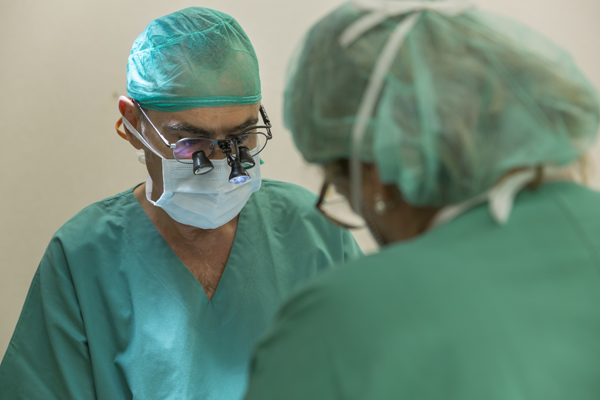
Known as Mohs surgery or micrographic surgery, this is the most specific surgical technique for the treatment of localized skin cancer. It consists of extirpating the tumor by layers and controlling the tumorous margins with a microscope. The objective is to remove the entire tumor while respecting the surrounding healthy skin to the utmost.
The tumors which are extirpated with this technique achieve the highest cure rates, although, due to its sophistication, it is not a technique which can be used for all skin cancers. Mohs surgery is very complex and is therefore performed in very few centers in Spain. Dr. Garcés is an expert in this technique and has performed over 2,000 Mohs surgeries during his career.
The intervention
Firstly, the affected area is anesthetized before extirpating the layer affected by the tumor. Once removed, the sample is prepared for analysis in the laboratory to see whether the tumor has been completely removed.
Hemostasis is carried out to prevent the wound from bleeding and to heal it provisionally while waiting for the laboratory results. These usually take around 30-45 minutes. During the wait, the patient can relax with a companion in our facilities at the Centro Médico Teknon.
If any cancerous cells have been detected in the analyzed tissue, the entire procedure is repeated on the affected area until the malignant cells are completely eradicated. It is a surgery performed in stages. Uncomplicated tumors normally only require one or two stages, but occasionally it is necessary to repeat the procedure three or four times to ensure the complete extirpation of cancerous cells. This may translate into an intervention lasting between two and four hours, depending on the type of tumor and its localization.
The wound and its cure
Once the entire tumor has been removed, it is time to decide upon the best solution to close the wound. In some cases it is better to leave it to heal on its own, which requires remedies at home for a few weeks. On other occasions, the wound is sutured or the patient is given grafts or other aesthetic surgery techniques.
Most patients notice a tightness or itching in the wound, but these symptoms will diminish over time. It is important to note that if the tumor affects the superficial nerve branches, it will take time for the patient to recover normal sensitivity. The definitive appearance of a wound is reached one year after the intervention.
